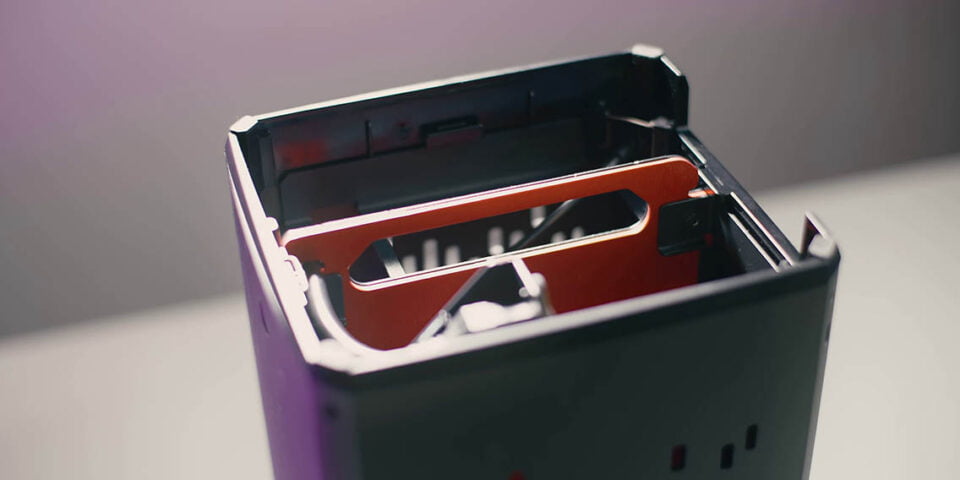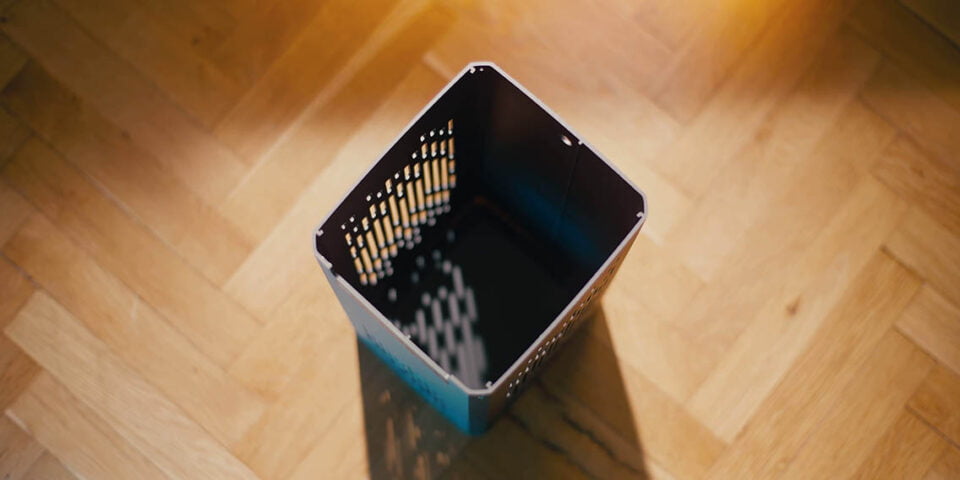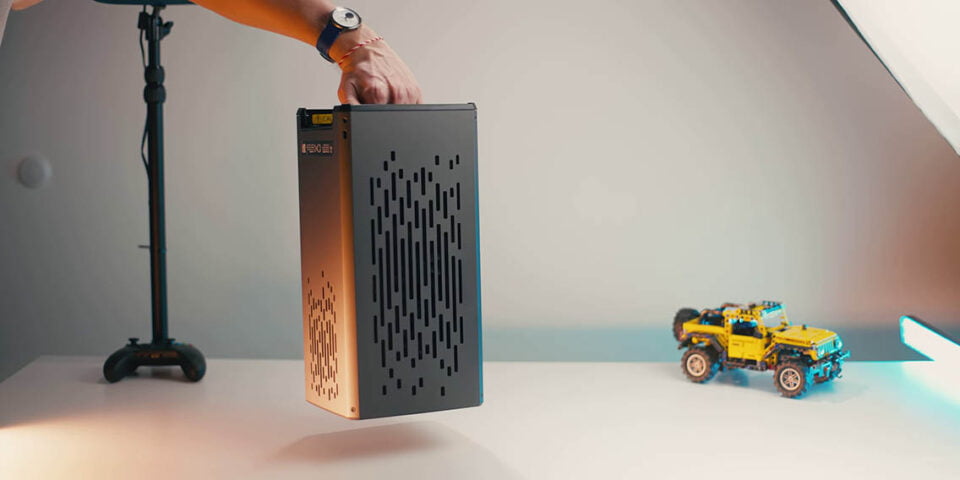
Louqe RAW S1 Review – A Raw Deal
2021-07-15Table of contents
I am so excited to finally experience a Louqe enclosure, they are the guys responsible for the Ghost S1, which is super popular and I would say successful in the ITX space due its modularity, its flexibility, and its compatibility with really good high-quality enthusiast components. This new enclosure the RAW S1 tries to follow in those footsteps of still offering raw power density but in a 12 liter enclosure.
I have to be honest my expectations for the RAW S1 are super high just because of everything the company has done with the Ghost series, but I will say that the RAW series, the S1 in particular, I don’t think is as flexible in terms of adding components and adding water cooling as the Ghost series because with their little top hat you can install a 240mm radiator there, which you can’t with the S1 Nevertheless, come along and experience my journey working with my very first Louqe case.
Build & Design
First of all, I love the towering ITX form factor for 2 reasons. Number 1 it minimizes footprint on your desk because the cases vertical, not horizontal, and Number 2 that vertical space allows for massive GPU support, so you don’t have to expand the case in any other direction but in height. Here it looks very similar to my Corsair ONE in terms of size and actual dimensions too. It is also very similar in size to the SSUPD Meshlicious as well and slightly smaller than the now recalled NZXT H1.
In terms of materials it is thick aluminium, so one solid shell on the exterior with those beautiful ventilation patterns that look kind of random, but also fit exactly where ventilation needs to happen. There are some plastic pieces, both on the top and the bottom of the frame, which kind of eliminates that premium feeling of an otherwise really solid enclosure. And once you remove the shell you can see there is a bit of flexing going on in that middle spine where your hardware sits and the base floor, which actually is plastic like the surrounding bits. I think it would have been very difficult to mold that part to the shape of the shell.
Overall though the case feels very solid, especially because we have a handle at the bottom and that’s kind of cool because it brings portability to the next level. My only complaint with the design – and that is totally subjective – is the exterior rhodium grey colour of the aluminum. It has greenish and warmish tones instead of the neutral dark grey tones that like we find with Apple products and other dark grey aluminum.
Connectivity
As for the case I/O we have a power button at the front and the USB-C extension that can be installed on either corner at the rear. This is an extension so you have to plug this directly into your motherboard backside instead of the internal USB-C connector, so keep that in mind otherwise you won’t have USB on the case whatsoever unless you go directly into the motherboard.
The Interior
Now to get inside that is a straightforward process, but a little bit more complicated than like removing a simple side panel. Louqe does include a Torx key with which you have to remove 4 screws, then you have to pop out the USB-C connection and the power button, both of which are easily done. Only then do you have access to remove that interior from the exterior shell. You can see it’s basically a rail system for the interior frame and the exterior shell. My sample here was extremely tight and that is something that I was not expecting for such a premium niche product. I was hoping for the build quality of those rails to be slightly better.
With the interior shell open we can see that this case can hold. The specs say CPU towers up to 75mm in height are supported, triple slot GPU’s up to 320mm in length, SFX or SFX-L power supplies are supported with an optional 120mm fan in front of the power supply set to exhaust. Unlike the Ghost S1, which had that radiator expansion for the top hat, I don’t see how that is possible with the RAW S1 because that exterior shell is one solid piece. I don’t see how they could mount something on top of it to expand its cooling potential. You can see the interior is red, which I found to be odd since it might peek out through the ventilation and reveal itself, but the case is really dark inside when you close the shell so it really is not a concern. Plus I kind of like the look of it.
Riser Cable
The PCIe Gen4 riser cable is really important and I’m happy that Louqe did it right. If you haven’t seen our article on the issues you might experience with riser cables check it out right here. In this case you can plug in a Gen4 GPU with a Gen4 compatible motherboard and everything should work just fine. The riser cable is blue, but it is wonderfully flexible allowing you to pass it underneath the motherboard and plug it into the PCIe slot on the motherboard without any issues whatsoever. This might be my favorite riser cable experience as of yet.
Assembly
Not for the main assembly, I was kind of dreading the part where I have to do cable management because I absolutely hate cable management in tiny ITX cases. However, in this case, because the shell is out everything is exposed so you have full access to 360 degrees around the enclosure, which lets you route the cables in a completely zero stress manner. Because the motherboard and the GPU are separated in those two chambers the cables don’t really mix, so you can do a really clean job on the main chamber and only then route the cables behind the motherboard for the graphics cards. I am very proud of how everything turned out in terms of cable management, even though I am using the shorter ITX cables for my SFX power supply.
The only downside in the entire user assembly and the user guide is the optional 120mm fan out in front of the power supply. Based on the user manual you mount that last, but there is no way to access the screws in front of the power supply because there is no clearance for your screwdriver because the power supply is right there. You can either use rubber screws like I did here or mount the fan first and only then mount the power supply. But then also you have to deal with that really tiny amount of space in front of the power supply and the fan for all your cables. Luckily they were able to jam in there just fine, but it did require some force to mount that bracket back in. The good thing is that we have lots of room between the power supply and that middle spine to stash all the excess cables in there, and also route the PCIe cables through it into the back chamber. You really have to make sure all your cables are collected and as tight as possible, especially because you will be populating that interior back into a really confined shell.
I would recommend turning on the system before placing the shell back on, and just as with the beginning that whole process of reinserting the shell into the frame was extremely tight to the point where I felt nervous about having my fingers around the frame because what if on one section goes in smoothly/quickly and I hurt a finger, that is not something you want to experience on such a enthusiast high-level niche expensive enclosure.
Price
Let’s talk about the price shall we? This thing is going to launch at €299 or $329 USD, which is a LOT. It is designed in Sweden and also made in Sweden, so that will cause part of the price premium, but I was expecting to have a slightly better experience overall. Not just because of the rail system but because of some imperfections on the aluminium edges, especially around the handle that were quite sharp and not as refined as they should be. I also don’t really like some of the plastic pieces, but I understand why they are there because molding that shape in the aluminum would have been even more expensive.
The GPU mount here is completely tool-less, it just requires you to screw back that big thumbscrew at the bottom that holds the GPU in place. Really the only limiting factor with components and compatibility would be the CPU cooler, because the best one right now under 75mm would be the Noctua LH-12S which I installed. It does perform very well in a default non-overclocked scenario, but I am using the same configuration as I test with all my ITX systems that means with the CPU overclocked to 5Ghz, which is extremely out of bounds for what this tiny cooler can handle.
Cooling & Noise
I tested temperatures for both the CPU and the GPU with the shell and without the shell, and overall cooling was actually quite decent. The CPU wasn’t throttling, which I found to be very impressive, but the GPU temperatures are really impressive. Overall, there is plenty of room between a dual-slot GPU and the shell to not create turbulence for airflow, but as soon as you go into like 2.5/3-slot cards then that fan will be right against the shell and that might create turbulence and additional noise as a result.
As for noise at full power, it’s going to be loud, but with some tweaking of the fan curves, especially for the CPU tower and that optional 120mm fan – which is actually louder than my CPU cooler fan – it’s totally manageable. By the way, there are no dust filters anywhere on the case, because that would worsen your cooling potential as it would be another barrier for airflow.
Since the motherboard is facing down all your I/O will have to be routed from there, and I don’t like that especially with the really massive DisplayPort cables that don’t flex very well. This layout does give you the cleanest cable exit from the bottom of the case near the surface and not like cable sticking out from somewhere in the middle.
Conclusion
My first experience with the Louqe enclosure is kind of mixed. I was expecting to have a bit more finesse and refinement like what I’ve seen with the Ghost series. I hoped that this would carry over into the RAW S1 series because it’s priced just as high. However, some of the edges of the aluminum are not refined, especially on the rail system, at least with my sample.
To explain the price a little bit more, the riser cable alone costs $100, which is 1/3 the price for the RAW S1. Let that sink in for a little bit. But this case is targeted towards that really enthusiast niche market, so $300 for people who want to build in this vertical tower, probably won’t be such a deal breaker. Especially when you have to consider the limitations with cooling, both for the GPU and CPU versus something slightly bigger that can accommodate a 240mm radiator. The Ghost S1 already does that, so I get that they want to do something different with the RAW S1. At the end of the day, I feel like they have checked off the mark about massive GPU support. Cable management was surprisingly simple despite having such compact dense package. It also has a built-in handle that is actually built into that spine so it won’t go anywhere and it gives me confidence of carrying the system around without any issues.
On the other hand, it does lock you in a certain path for your CPU and your CPU tower heatsink choice, because of that small 75mm tower clearance. But it’s something that many Louqe users have already accepted and I feel like they are just continuing with that trend. And that’s it, I hope you enjoyed this review. Let me know what you think of the Louqe RAW S1, is it a worth follow up to the Ghost S1?.












